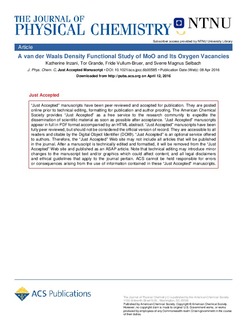A van der Waals Density Functional Study of MoO3 and Its Oxygen Vacancies
Journal article, Peer reviewed
Accepted version
Permanent lenke
http://hdl.handle.net/11250/2452472Utgivelsesdato
2016Metadata
Vis full innførselSamlinger
- Institutt for materialteknologi [2549]
- Publikasjoner fra CRIStin - NTNU [38127]
Originalversjon
Journal of Physical Chemistry C. 2016, 120 (16), 8959-8968. 10.1021/acs.jpcc.6b00585Sammendrag
The electronic structure of layered molybdenum trioxide MoO3 is highly sensitive to changes in oxygen stoichiometry as Mo6+ has an empty 4d shell. Applications of MoO3 are responsive to small changes in vacancy concentration, with some functions relying on a narrow window of oxygen nonstoichiometry. Difficulties in analyzing the energetics of oxygen vacancies by computational methods stem from the inability to accurately model the layered structure of MoO3. One unit cell parameter is governed by long-range forces across the structural gaps, and these dispersed interactions are not well described by conventional density functional theory (DFT) methods. With the exchange functional vdW-DF2, we accurately model the structure, in good agreement with experimental data. This basis allows exploration of the effect of oxygen nonstoichiometry on the electronic structure and properties of the oxygen-deficient material. The layered structure efficiently screens the structural perturbations caused by oxygen vacancies. The enthalpies of formation are calculated for oxygen vacancies at the three symmetry inequivalent oxygen sites. The oxygen deficiency in MoO3 gives rise to Mo 4d gap states with energy levels dependent on the type of oxygen vacancy.
